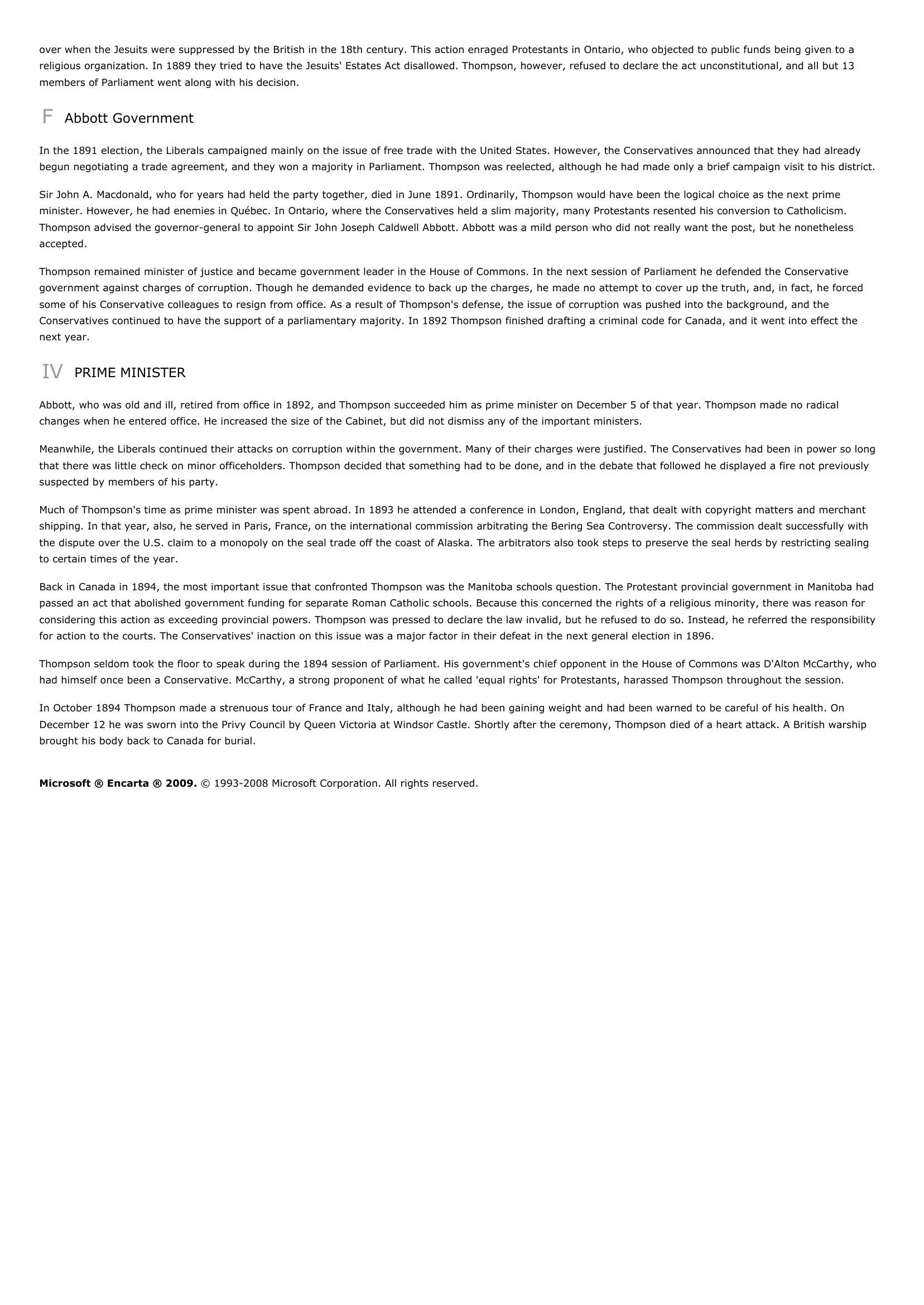Sir John Thompson.
Publié le 10/05/2013

Extrait du document
«
over when the Jesuits were suppressed by the British in the 18th century.
This action enraged Protestants in Ontario, who objected to public funds being given to areligious organization.
In 1889 they tried to have the Jesuits' Estates Act disallowed.
Thompson, however, refused to declare the act unconstitutional, and all but 13members of Parliament went along with his decision.
F Abbott Government
In the 1891 election, the Liberals campaigned mainly on the issue of free trade with the United States.
However, the Conservatives announced that they had alreadybegun negotiating a trade agreement, and they won a majority in Parliament.
Thompson was reelected, although he had made only a brief campaign visit to his district.
Sir John A.
Macdonald, who for years had held the party together, died in June 1891.
Ordinarily, Thompson would have been the logical choice as the next primeminister.
However, he had enemies in Québec.
In Ontario, where the Conservatives held a slim majority, many Protestants resented his conversion to Catholicism.Thompson advised the governor-general to appoint Sir John Joseph Caldwell Abbott.
Abbott was a mild person who did not really want the post, but he nonethelessaccepted.
Thompson remained minister of justice and became government leader in the House of Commons.
In the next session of Parliament he defended the Conservativegovernment against charges of corruption.
Though he demanded evidence to back up the charges, he made no attempt to cover up the truth, and, in fact, he forcedsome of his Conservative colleagues to resign from office.
As a result of Thompson's defense, the issue of corruption was pushed into the background, and theConservatives continued to have the support of a parliamentary majority.
In 1892 Thompson finished drafting a criminal code for Canada, and it went into effect thenext year.
IV PRIME MINISTER
Abbott, who was old and ill, retired from office in 1892, and Thompson succeeded him as prime minister on December 5 of that year.
Thompson made no radicalchanges when he entered office.
He increased the size of the Cabinet, but did not dismiss any of the important ministers.
Meanwhile, the Liberals continued their attacks on corruption within the government.
Many of their charges were justified.
The Conservatives had been in power so longthat there was little check on minor officeholders.
Thompson decided that something had to be done, and in the debate that followed he displayed a fire not previouslysuspected by members of his party.
Much of Thompson's time as prime minister was spent abroad.
In 1893 he attended a conference in London, England, that dealt with copyright matters and merchantshipping.
In that year, also, he served in Paris, France, on the international commission arbitrating the Bering Sea Controversy.
The commission dealt successfully withthe dispute over the U.S.
claim to a monopoly on the seal trade off the coast of Alaska.
The arbitrators also took steps to preserve the seal herds by restricting sealingto certain times of the year.
Back in Canada in 1894, the most important issue that confronted Thompson was the Manitoba schools question.
The Protestant provincial government in Manitoba hadpassed an act that abolished government funding for separate Roman Catholic schools.
Because this concerned the rights of a religious minority, there was reason forconsidering this action as exceeding provincial powers.
Thompson was pressed to declare the law invalid, but he refused to do so.
Instead, he referred the responsibilityfor action to the courts.
The Conservatives' inaction on this issue was a major factor in their defeat in the next general election in 1896.
Thompson seldom took the floor to speak during the 1894 session of Parliament.
His government's chief opponent in the House of Commons was D'Alton McCarthy, whohad himself once been a Conservative.
McCarthy, a strong proponent of what he called 'equal rights' for Protestants, harassed Thompson throughout the session.
In October 1894 Thompson made a strenuous tour of France and Italy, although he had been gaining weight and had been warned to be careful of his health.
OnDecember 12 he was sworn into the Privy Council by Queen Victoria at Windsor Castle.
Shortly after the ceremony, Thompson died of a heart attack.
A British warshipbrought his body back to Canada for burial.
Microsoft ® Encarta ® 2009. © 1993-2008 Microsoft Corporation.
All rights reserved..
»
↓↓↓ APERÇU DU DOCUMENT ↓↓↓
Liens utiles
- Sir John Sparrow David Thompson - biography.
- Sir John Thompson - Canadian History.
- MUTINERIE ET LA CAPTURE PIRATESQUE DU H.M.S. « BOUNTY » (La) de Sir John Barrow
- RECHUTE (La) ou La vertu en danger de Sir John Vanbrugh. Résumé et analyse
- Millais, sir John Everett - vie et oeuvre du peintre.

































